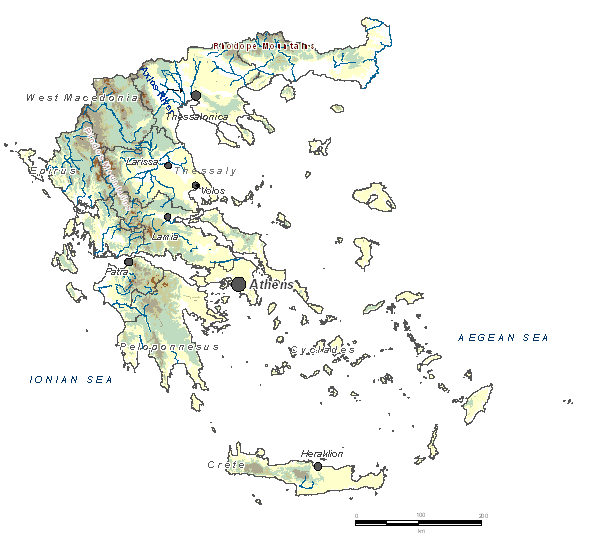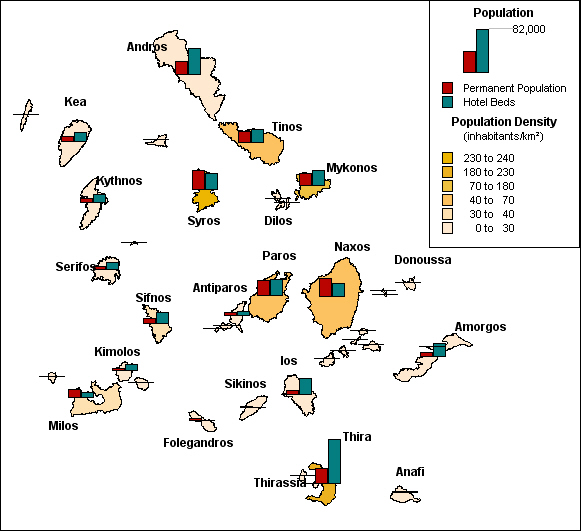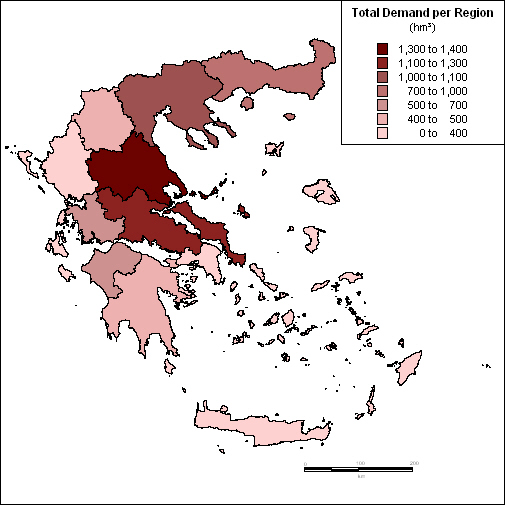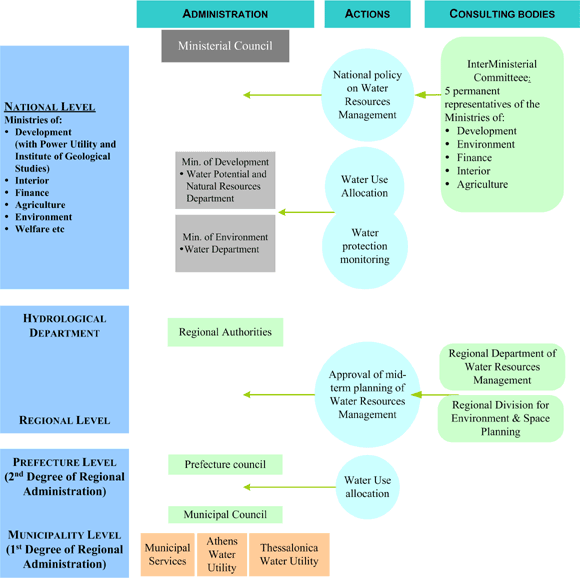
|
|
|
|
| |
 Editorial Editorial |
|
The identification of the Range of
Circumstances in the Participating Countries has been the main
outcome of
the analysis phase in the WaterStrategyMan Project.
In order to determine the
issues faced in managing water resources in arid and semi-arid
regions, a detailed definition was sought of the current conditions in water
deficient regions in terms of water resources, water supply, use
patterns, water management practices and policies.
The project partners, therefore, determined those conditions in the
designated countries, and
through these reviews selected regions facing water scarcity for
further study.
Fifteen regions were
eventually selected as candidates for case study, and were further analyzed with respect to their specific
characteristics. Of those, six were the ones finally picked as
representative case studies, after a comprehensive typology analysis
according to the identified water related problems.
This issue of the WSM Newsletter
showcases the Range of Circumstances in Greece and in the three Greek candidate regions, Attica,
Thessaly and the Cyclades Islands. This editorial is
followed by a summary overview of the country, while the detailed texts can
be found by clicking the links under "Topics" in the left
bar.
The following Newsletter issues will
present the wide range of
circumstances in the other five countries (Italy,
Spain, Portugal, Cyprus and Israel) and an overview of the
candidate regions.
|

|
|
The
WaterStrategyMan
Project (Developing Strategies for Regulating and Managing Water Resources
and Demand in Water Deficient Regions / WSM), is supported
by the European Commission under the Fifth Framework
Programme, under the Key Action "Sustainable Management
and Quality of Water".
|
|
 Overview of Greece
Overview of Greece |
Introduction |
|
Greece has
one of the greatest water resources potentials per capita in the
Mediterranean area, and theoretically should have ample water for
its population and traditional water uses; however water is not
evenly distributed in space and time.
The maximum
precipitation is recorded in the western parts, where the available
water resources are consequently plentiful, while in other regions
of the country precipitation is much lower and available water
resources are insufficient to meet a growing demand.
Due to this
inequality in water distribution, both in space and time, some areas
of Greece, such as Attica and the Aegean Islands are facing
long-term water shortage problems.
The permanent population of Greece according to
the 2001 census was 10,964,080 inhabitants. The recorded tourist
arrivals for 1998 were 11,363,822.
|
The climate in general is
Mediterranean but varies significantly throughout the country due to
various factors (the country being almost surrounded by
sea, its geomorphology, and the north – south direction of the main
mountainous chain).
In the country there are no plains in the geographical sense
but only basins formed between mountain chains. One of the main
characteristics of the country is its extended coastline and the
significant number of islands. Geological formations are mainly composed of limestone and
sedimentary rocks.
Figure 1 presents
the geomorphology of the country, and Figure 3 shows the average precipitation
per administrative region. These are 13 in total, and their
boundaries do not
entirely coincide with the 14 water regions (hydrological
departments).
|
|
 |
|
Figure 1. Geomorphology of Greece
|
|
|
Water Demand and Supply
Status |
|
Water demand peaks in the
hot and dry summer months, when water availability is at its lowest,
due to the decrease in precipitation. The summer peak is due to the
heat that encourages increased water usage, to the tourist
activities and to the
current irrigation practices and cultivated crop types.
In addition to the limited water resources, water pressure
in some parts of the country may also be attributed to the large influx of visitors from other
parts of the country or from abroad. Figures for tourist numbers
vary from year to year and between measurements. The Aegean Islands have the
highest visitor/tourist number compared to the permanent population.
For example, in August the peak number of visitors to the Aegean Islands is on
the average ten times greater than the local population, and in
certain islands it is even thirty times the local one (Figure 2).
|
Approximately 14 km3/y of
water entering Greece (about 30% of total average annual water
resources) originates in neighbouring nations, where the water is
both abstracted and used for effluent disposal.
The estimated
amount of stored groundwater is about 10,300 hm3/year,
formed primarily in sedimentary materials.
Nearly 100% of the Greek population is
connected to water supply and power utilities, while 76% of the
population is connected to sewerage and wastewater treatment
networks. Figure 4 presents
the water demand per region, while Figure 5 shows the Consumption
Index per Region. The Consumption index is the ratio of water
consumed over the total water resources, expressed as a percentage. |
 |
|
Figure 2. Population density
vs. accommodation availability
in the Cycladic Islands (1996) |
|
Conflicts arise in cases that the rivers are overabstracted upstream, and
where the quality of the waters deteriorates to the point that it
cannot be used for its intended use downstream. Since international
agreements are still pending and the rate of exploitation increases
in the upstream countries, quantity conflicts are also due to
happen.
- In areas dependent on tourism,
as the domestic
supply takes priority over irrigation, conflicts invariably arise
between the municipal water supply and the local farmers. The available water
resources in the Greek islands are very limited, and with few
exceptions consist of groundwater contained in the local aquifers.
Overabstraction of those aquifers leads to salinisation of
the water rendering it mostly unusable. The soils in the islands
are extremely vulnerable to erosion with resulting problems in
developing the water resources.
|
- In agricultural areas conflict arises due to the excessive
demand for irrigation water, while large quantities are required
for domestic supply, tourist activities and for maintaining the
ecological characteristics of the surface and ground water of the
area. The agricultural activities and practices in Greece have
neither been “modernised” nor adapted to current requirements and
standards, leading to vast amounts of water used for irrigation
(85% of all demand), that could be drastically reduced through the
introduction of more efficient irrigation networks and a better
selection of crops in terms of water needs.
- In urban centers the main area for conflict is the transfer
of water from other, richer in water resources regions, or the
exploitation of water resources that would be used for irrigation.
The Metropolitan Athens Area and Thessalonica are both water
deficient urban centres.
|
 |
|
Figure 3. Average precipitation
in the 13 administrative regions
|
|
|
Environment and
protection |
|
Coastal waters
of Greece are of good quality, with the exception of areas where
effluents from the larger cities are
discharged. The same does not apply to the surface and
ground waters. Domestic effluents and
agrochemicals are a major source of surface and groundwater
pollution, despite the existing EU legislation for wastewater
treatment. Until now, water pollution has been one of the main
issues in trans-boundary water resources, as the disposal of raw
domestic and industrial effluents has had profound effects on rivers.
No effluent charging systems exist and the sewage is discharged into
the wastewater system for a nominal charge.
|
The quality of Greek river systems is
dependent on the time of the year; water levels decrease
significantly in the summer allowing higher concentrations of
pollutants. Overabstraction and saline
intrusion in the underground aquifers exacerbates the problem of
groundwater deterioration and increases the water shortage problems.
Another important issue is the occurrence of periodic droughts and floods in increasing frequency in the recent years. The combination of prolonged drought periods with intermittent
floods after torrential rainfall worsens the pollution problems
of urban and agricultural runoff.
|
 |
|
Figure 4. Water Demand in the
13 administrative regions
|
|
|
Institutional framework and constraints |
|
The administration and management of water is
at the moment undergoing major changes due to the process of Greek
legislation harmonization with respect to the European Water
Framework Directive. At present, new legislation has been announced
but not yet submitted for approval to the Parliament. Therefore the
description of the institutional framework and
management of water resources in the following paragraphs refers to the current situation
and does not reflect the
Water Framework Directive values and principles.
Responsibility on water
allocation and management is distributed in the national, regional
and local levels of administration. The initial allocation of water
is effected by the Ministry of Development, which is responsible for
water allocation to individual uses, as well as for the management
of water designated for industrial use. Once the initial allocation
is effected, the water for each use falls under the responsibility
of the respective ministry.
On the regional level, the
regional authorities are responsible for the approval of planning
and financing for projects involving water supply and irrigation.
|
Prefecture authorities are responsible for the issuing of permits
for abstraction and for the allocation of water within each
region/use. On the local/municipal level, the municipality is
responsible for the supply water and services to the people, or, for
the creation of public companies responsible for the provision of
water and sanitary services.
The most pressing issue is
the fact that there are many government departments dealing with
water problems, but their activities are compartmentalized and not
well coordinated.
Added to this is a water law system which is not
responsive to integrated water resources management and widely
scattered, thus permitting overlapping functions, multiple advisory
bodies and insufficiently decentralized management responsibilities
through regional organizations. Legislation also tends to be deficient in the
case of pollution issues, where quality standards for water bodies
and/or effluent disposal have not been clearly established.
A Master Plan has yet to be
formulated along with the corresponding management principles for
the 14 water regions.
|
 |
|
Figure 5. Consumption Index
in the 13 administrative regions
|
|
|
Management, Institutional and policy options |
|
The Greek legal system includes several laws and regulations for the allocation of water
resources, the management of water resources and services, and the
quality and quantity aspects of water regarding each use. According
to Article 24 of the Greek Constitution, the protection of the
natural environment is a responsibility not only of the state but
also of the citizens. The state is under obligation to take
preventive and corrective measures for the protection of the natural
environment, both on the legislative and the administrative level. The protection of water
resources is also regulated by a number of international agreements
and legislation.
Currently the focus in
Greece is on growth policies rather than on water resources
management and policies. Law 1739/1987 (which as mentioned above is
under revision) provides the basic framework
for water management, which is however not currently fully applied.
The management of resources is essentially effected on a regional
level, after the initial allocation to uses.
The management of water resources is
often poor and
disorganized in the municipal level. Maintenance of infrastructure in the more remote areas
tends to be poor, while long term contingency planning is almost
non-existent. Financial constraints are the main reason behind the
poor management and lack of planning.
Figure 6 presents the decision making process in Greece as it currently stands.
|
Overall short-term responses
to water challenges are driven by crises that require the
confrontation of the acute shortages. In cases of water shortage,
supply augmentation management options are used most often.
Demand reduction management principles have
been used in the past, particularly in the Athens Metropolitan Area
in the early 1990’s, where increased water prices were successfully
used to compensate for the prolonged drought that led to severe
water shortages. However, such measures are not widely used as the price of water tends
to play a pivotal role in political processes.
The means used to
confront water shortages have depended mainly on the cost of the
method; the first response to water shortages invariably
involves new drilling of the aquifers. An alternative way
of ensuring water supply is importing water from neighbouring,
richer in water areas, and for permanent water shortage other structural solutions are
preferred - dams and reservoirs are used where there are funds
available, and locations suitable, for their construction. Desalination plants are also used in cases of more
limited funds or lack of suitable locations.
There is great need for new
approaches to water management that will mitigate such problem issues and constraints, and promote
sustainable use of the available resources. A strategic approach is
required
that should include drastic measures of ecological rehabilitation,
innovative institutional mechanisms, and a balance between autonomy
and cooperation.
|
 |
|
Figure 6. The current decision making
process
|
|
|
Summary of water-related issues in
Greece |
- Dependence on transboundary waters flowing from non-EU regions,
which are very difficult to regulate,
particularly in matters of quality; the lack of infrastructure
in the neighboring countries results in pollution downstream into
Greek waters.
- Strong dependence on irrigation. Even with the best management
techniques and strategies, agriculture will remain the major user
of water in the country, due to the hot and dry climate.
- Pronounced seasonality of demand, which makes the provision
of water services harder, as it is not always possible to ensure
adequate supply.
i) The demand that is due to tourism peaks in the summer when a major influx of tourists is
observed.
ii) The demand for agriculture peaks in the
dry hot season, the same time as the domestic demand peaks due to
tourism.
- Uneven distribution of resources. Both precipitation and surface water resources are concentrated in the
western and northern parts of the country that are self-sufficient,
while the eastern and southern parts of the country face water
shortages.
- Water quality deterioration due to human activities.
|
- Uneven distribution of population and hyperurbanization. The population is
largely concentrated in the eastern coastal areas which
tend to be under stress. Furthermore, the concentration of almost
half the Greek population in Athens, in the poorest water region
of the country, and the seasonal influx of visitors to the Greek
islands, exacerbates the water shortage problems.
- Overexploitation and salinisation of aquifers, which is a common
problem in the areas dependent on groundwater, and particularly
in coastal areas.
- Focus on short–term developmental policies rather on the
actual water resource management.
- Lack of inter-ministerial coordination and overlaps in areas
of authority. Instead of an organized, coordinated approach to
water resources management, measures taken are only partial and
generally ineffective.
- Absence of master plans or national guidelines for comprehensive
planning and management in the past, despite recent efforts for
responding to that problem.
- Lack of organized, collective efforts, which are required to
respond to the demanding provisions of the Water Framework Directive
and other EU legislation and operational guidelines.
|
|
|
|
|
